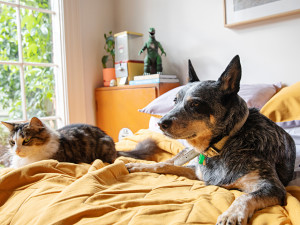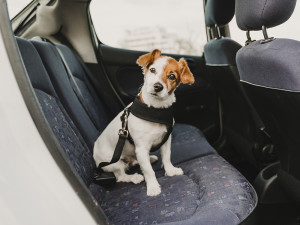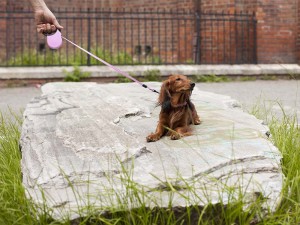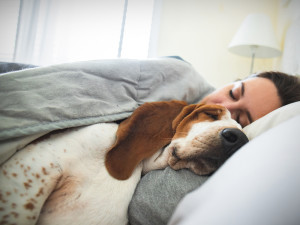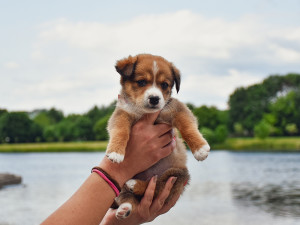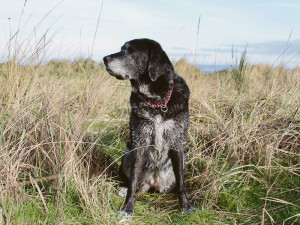What to Do If Your Pup Goes Missing
How to get your dog home, should the worst happen
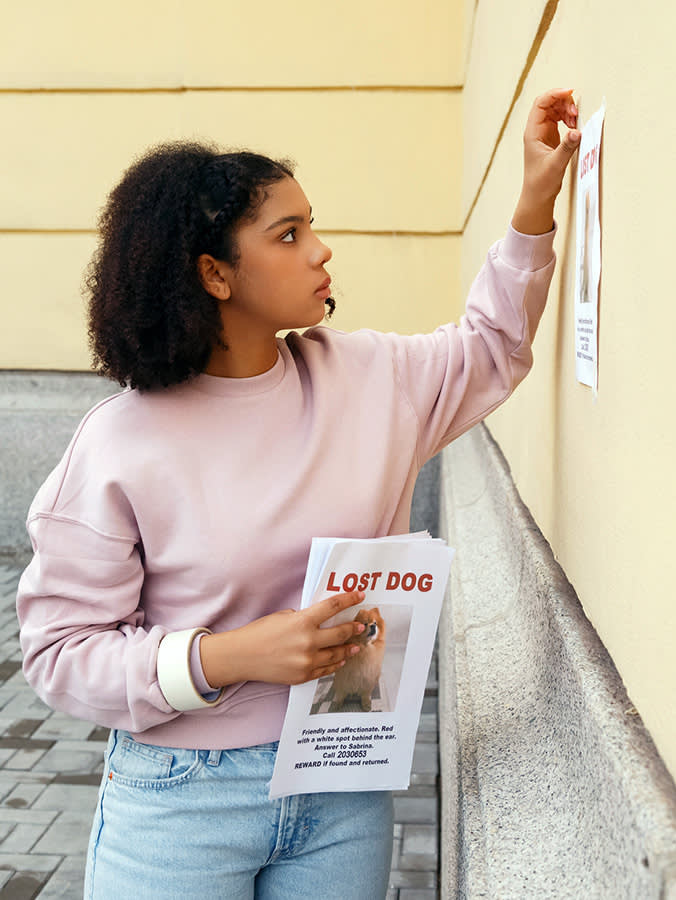
share article
That feeling when you realise your beloved furry friend is nowhere to be found is heart-wrenching enough to send even the most composed pet parent into a panic. Whether your pup has made a Houdini-style escape or has got spooked on a walk, that gut punch of a feeling is one no pet parent should have to suffer.
The key is being prepared, so that if you’re ever in the awful position of missing your pet you’ll know what to do and leap into action when time is of the essence. With a little help from the experts, we’re here to guide you through the nerve-wracking process of bringing your four-legged family member back home.
First things first, double check your dog’s microchip registration is correct and registered with a legitimate database that meets government standardsopens in a new tab. Particularly if you have a pup that’s come from abroad, make sure they’re registered to a UK database. “A few databases have lost registrations and there is also a fraudulent database allowed to trade in the UK,” says a spokesperson for Stolen And Missing Pets Allianceopens in a new tab (SAMPA) and DogLost.co.ukopens in a new tab, so make sure it’s a DEFRA-approved databaseopens in a new tab. That way, if the worst should happen, you’re already one step ahead. Here’s what to do next if your dog ever does make the dreaded Great Escape.
What to do if your dog goes missing
Stay calm
We get it; panic is the first emotion that hits. But pausing a moment, taking a deep breath and reminding yourself that Fido might just be on an extended adventure can help gain some sought-after perspective. Animals are curious beings, after all. Before you unleash your inner detective, check all the usual hiding spots and favourite nap locations. Sometimes, they’re just having a siesta in the most unexpected corners of the house or garden.
Flag them as missing
Double check the details on your dog’s microchip registration are correct and flag your dog as missing with the database. Acting quickly can make all the difference; if your pet’s microchip is scanned (if they’re picked up by a kind citizen or animal warden, for example) it can trigger an alert and notify the scanner that you’re searching for your dog.
Then, it’s about contacting local vets (in case your dog is brought there) and your local animal warden to report your dog as missing, as “if someone finds your dog there is a legal obligation to report them to the animal warden”, the SAMPA spokesperson adds. Your local authority (council) has a mandatory responsibility for any found dogs and you can find the number for your local authority on the Animal Warden websiteopens in a new tab.
Next, register on Doglost.co.ukopens in a new tab, the largest lost and found website in the UK. “It’s free and comes with a police liaison team,” they add. The volunteer-run organisation also creates instant posters to share on social media, and “email alerts are sent to local people who may not be on social media”. You can also search the DogLost website to see if anyone has already picked up your pup and flagged them as found.
Get on social media
Now’s the time to leverage those followers for good. DogLost representatives will be able to help and advise, and share descriptions, posts and pictures on the organisation’s own social media accounts (as well as its wide-reaching network of email contacts) to get your missing pup in front of as many people as possible. Create a shareable post and ask your friends and followers to spread the word, and also use local community groups and dog lover groups to your advantage and share information about your missing pet.
Create posters
Don’t pooh-pooh the poster. In an age of technology and social media, it might seem redundant to create old-fashioned posters, but “posters really do help to bring home dogs.”
Include two clear pictures of your pup, as well as a clear description of any distinguishing features, at least two contact numbers and a message for finders to not approach or chase your dog. As they’re already feeling lost and scared, they don’t need strangers running around after them. Put posters up in the area your pup went missing, as well as high-footfall areas in the local neighbourhood, community boards and local gathering spaces such as corner shops (or even the pub).
Sometimes a little incentive goes a long way. Offering a small reward for information leading to your pet’s safe return could be a win-win – your pet gets to come home, and someone in your community gets a little extra pocket money.
When you start to get calls, note down every sighting you get, asking callers for times, locations, the direction they were heading in and the behaviour of your pup at the time. Stay calm, and patient, it might take a while as your dog is in fear mode, but the reunion will be worth it in the end.
If your dog goes missing from home
If you’re able to, and weather permits, keep a gate or door open overnight for your pup to come back to. Leaving your dog’s bed, toys and blankets outside, as well as their usual food, will help increase your chances of your pup making their own way back successfully, surfing on the familiar scents of home. Keep one pet parent at home, waiting for the happy reunion, whilst another pet parent, or trusted friend or family member if there’s only one of you, goes door knocking on your neighbours’ doors. Making them aware early on will make sure they keep an eye out for your pup in their own homes, gardens or even when they’re walking around the local area.
If your dog goes missing from a walk
So as not to overwhelm your pup (who is probably just as worried as you about being missing), keep search parties to a small size where possible, as the noise and different scents can be confusing for them. Pet parents should retrace the path taken on the walk alone, or with another recognised friend or family member, advises the SAMPA and DogLost spokesperson.
If you’ve driven to your walkies destination, head back to your car. You might think of it as just a vehicle to get from A to B, but it’s filled with all the familiar scents that your pup will recognise as home. If you can (and the weather permits), keep a door or the boot open and wait for your dog to smell you out (literally).
Your dog is most likely to try and find their way back to where they were lost from, the car or home, if it’s nearby. Try and allow your dog to return on their own in the first instance, and have trusted (by both you and your pup) friends or family members at each location.
What to do if your dog is stolen
“If you see your dog being stolen, call the police on 999,” says the spokesperson for SAMPA, as a crime is in the process of happening. Take note of as many details as you can from a safe vantage point and relay the information to the police. If you believe your dog has been stolen after the fact, call the police on 101 to report and ask for a crime reference number (CRN).
Follow the same steps as above, alerting vets, dog wardens, rescue centres and in particular, the microchip database that your pup is registered to, asking them to flag as stolen. When getting in touch with an organisation such as DogLost, send over the CRN so they can also flag as stolen, and spread the information amongst its network of volunteers.
Despite furry friends being a part of the family, stolen pets are currently regarded as personal property, with sentences dependent on monetary value. However, there is an open petition to make pet theft a specific crimeopens in a new tab, which would mean the government would have to implement stricter sentencing for perpetrators.
Remember, the most important thing is to stay proactive. The sooner you act, the better your chances of bringing your lost pet back home. So don your detective hat, gather your search party and bring that wagging tail back into your life.

Orla Pentelow
Orla Pentelow is a freelance journalist and copywriter based in London. When not at her desk she’s out and about with her rescue dog, Luna, who works primarily as chief distractor.
Related articles
![Dachshund dog freezing on a rock during a walk]() opens in a new tab
opens in a new tabWhy Does My Dog Turn Into a Statue on Walks?
Suddenly, the pavement has some new installation art: your frozen dog
![Woman and dog sleeping together in bed]() opens in a new tab
opens in a new tabWhere Should Your Dog Sleep At Night-Time?
It’s a personal preference, but here are the pros and cons
![Two hands holding a very young tan and white puppy up in front of a lake landscape]()
How to Socialise a Puppy
Everything you need to know to get your new addition off to a good start
![Portrait Of Large, Senior, Mixed Breed Dog On Beach]() opens in a new tab
opens in a new tab10 Tips for Grieving a Pet
We asked five grief experts how to cope with feelings of guilt after we lose a pet
